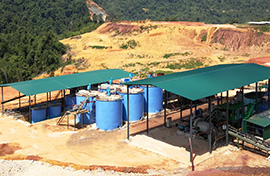-
 E-mail
guhaixin0724@gmail.com
E-mail
guhaixin0724@gmail.com
-
 Call Us
008613683147042
Call Us
008613683147042
 E-mail
guhaixin0724@gmail.com
E-mail
guhaixin0724@gmail.com
 Call Us
008613683147042
Call Us
008613683147042
2020-04-24 Views: 5456
Warm Tip: If you want to know more information, like quotation, products, solutions, etc., please Click here ,and contact us online.

In this post you're going to know about combined flotation reagents.
This guide also includes:
Definition of Combined Flotation Reagents
Why Combined Flotation Reagents Useful
Types of Combined Flotation Reagents
So if you want to learn how to use combined flotation reagent properly, you'll love this post.
Let's dive right in!
Combined flotation reagent is a flotation reagent system that uses two or more flotation reagents with the same or different types and structures in a certain proportion to improve the flotation effect.
The flotation effect of combined flotation reagent is usually better than that of any kind of flotation reagent alone. This effect is called a synergistic effect, and the reagent used is called a combined reagent.
Combined flotation reagents can improve the flotation effect, so it has been widely used in the flotation and flocculation of metallic sulfide ore, metallic oxide ore and non-metal ore.
On the one hand, the reason for the better collection effect of mixed flotation reagent may be the unevenness of the surface of the mineral. Different types and characteristics of the reagent can be selectively adsorbed in different intervals or parts to increase the adsorption density of the reagent on the surface of the mineral and the coverage of the reagent, and increase the hydrophobicity of mineral surface.
On the other hand, it may be due to the "co-adsorption" of different reagents on the mineral surface, which enhances the adsorption of the collector on the mineral surface.
There is no unified understanding of the mechanism of the synergistic effect of combined flotation reagents. Researchers discussed the effect of combined flotation reagents from different perspectives, such as chelation mechanism, combination mechanism, co-adsorption theory, performance differences, synergy and correlation of different components of the flotation reagent.
However, the following views are consistent:
1) The differences in the structure and performance of each flotation reagent in the combined flotation reagents, the length of the carbon chain, promote the complementary effect between them, and enhance the adhesion between the mineral particles and the bubbles, thereby improving the flotation process and effect.
2) The adsorption amount of the combined flotation reagents on the mineral surface is greater than that of the non-combined flotation reagent;
3) The adsorption area on the surface of the mineral particle is divided into strong and weak, and the effects of the different flotation reagents participating in the combination on the mineral are also strong and weak, which results in more uniform adsorption of the flotation reagents on the surface of the mineral particles using combined flotation reagent.
The types of combined flotation reagents include:
1) Combined (mixed) use of the same series of flotation reagents, such as low-level and high-level xanthates.
2) Combined (mixed) use of solvent, emulsifier and wetting reagents, such as kerosene, diesel oil and emulsifier.
3) Combined (mixed) use of same kind of flotation reagents, such as the co-use of various sulfide ore collectors, such as the co-use of soluble and insoluble reagents with different strengths and weak performances. Usually use one as the main and the other as the supplement.
4) The cationic collector combined use with the anionic collector, such as the co-use of dodecylamine and sodium oleate or xanthate.
There are two explanations for the mechanism of these combined flotation reagents.
One is that in an acidic medium, the cation collector is adsorbed by ions, and the anions are adsorbed by neutral molecules (the opposite is true under alkaline conditions).
The other is that the cationic agent is first adsorbed on the surface of the negatively charged mineral, so that the sign of the surface charge of the mineral becomes positive, which is beneficial to the adsorption of the anionic agent.
The former is called molecular ion co-adsorption mechanism, and the latter is called "charge compensation" mechanism.
5) Combined use of oxidized ore collector and sulfide ore collector.
6) Combined use of macromolecules and micromolecules reagents.
For example, the so-called poly-combined collector is an aqueous solution mixture made by mixing a poorly water-soluble polymer with a common collector. It is believed that the performance of the composite is better than the original collector.
7) The combined use of conditioners is common.
In addition, with the development of combined flotation reagents, the reagents used are not limited to the combination of various collectors, but also include the respective combinations of flocculants, foaming agents and conditioners, as well as the combination of inhibitors and collectors.
Among them, the combination and use of different inhibitors are more extensive. For example, sulfur dioxide is mixed with starch to inhibit lead sulfide, zinc and iron ore; cyanide is mixed with zinc sulfate to inhibit sphalerite and pyrite.
From the aspect of flotation reagent performance structure, there are mixed use of cationic, anionic and non-ionic equivalent flotation reagents, and there are also mixed use of these three types of flotation reagent.
Combined flotation reagents can improve mineral flotation performance and index, reduce the dosage or cost of the flotation reagents, and expand the adaptability of the flotation reagents.
And because there is no need to change the original flotation process, only changing the flotation reagent system can achieve the purpose, and the effect is quick, the combined flotation reagent is widely used.
According to their own situation, the flotation plant can refer to the practical experience of similar flotation plants and combine the results of the flotation test to carry out combined flotation reagents to obtain better flotation results.
No. 188, Xinhai Street, high-tech Industrial Park, Fushan District, Yantai, Shandong, China.

Please leave your message here! We will send detail technical info and quotation to you!